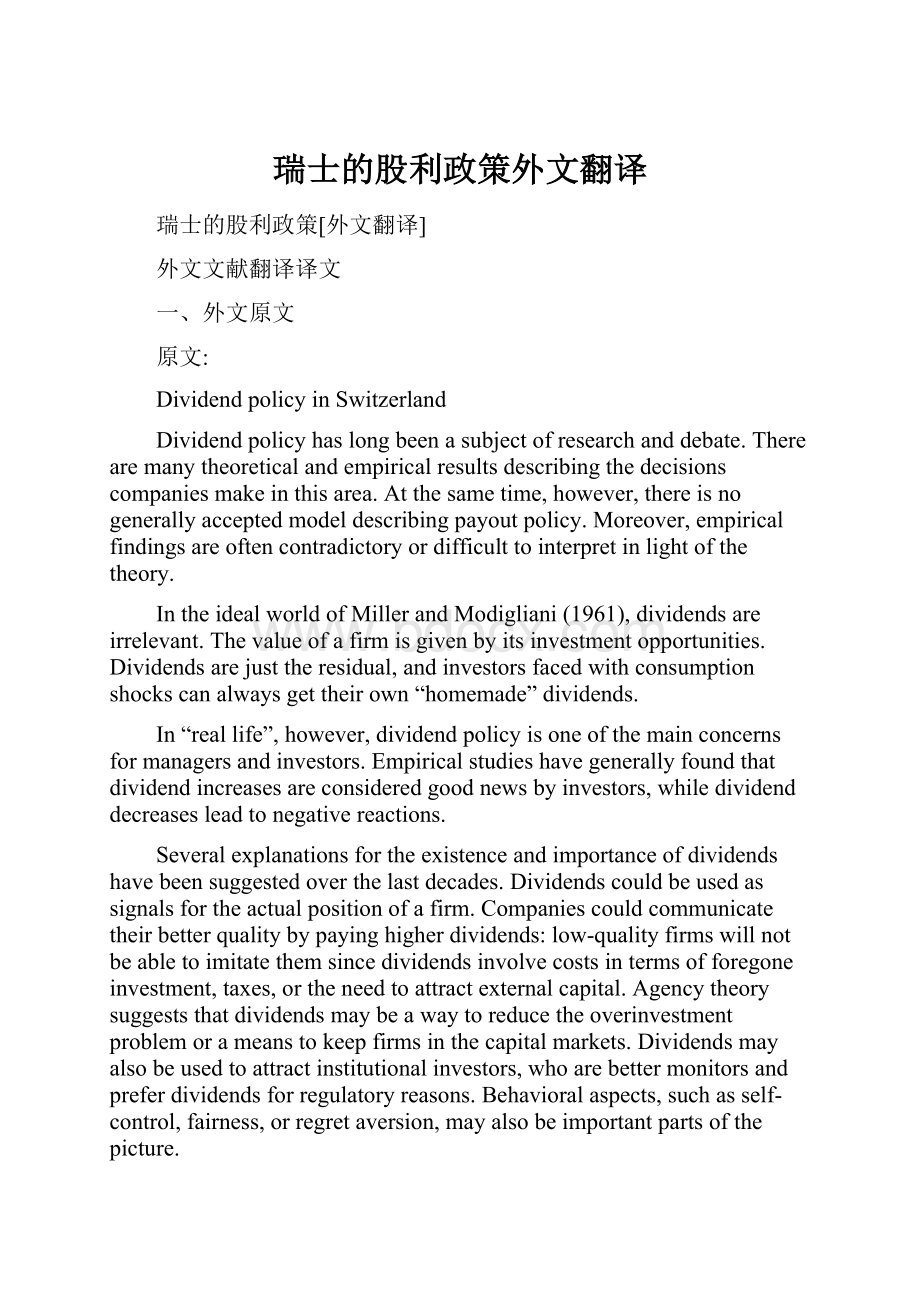 瑞士的股利政策外文翻译.docx
瑞士的股利政策外文翻译.docx
- 文档编号:9502313
- 上传时间:2023-02-05
- 格式:DOCX
- 页数:12
- 大小:24.03KB
瑞士的股利政策外文翻译.docx
《瑞士的股利政策外文翻译.docx》由会员分享,可在线阅读,更多相关《瑞士的股利政策外文翻译.docx(12页珍藏版)》请在冰豆网上搜索。

瑞士的股利政策外文翻译
瑞士的股利政策[外文翻译]
外文文献翻译译文
一、外文原文
原文:
DividendpolicyinSwitzerland
Dividendpolicyhaslongbeenasubjectofresearchanddebate.Therearemanytheoreticalandempiricalresultsdescribingthedecisionscompaniesmakeinthisarea.Atthesametime,however,thereisnogenerallyacceptedmodeldescribingpayoutpolicy.Moreover,empiricalfindingsareoftencontradictoryordifficulttointerpretinlightofthetheory.
IntheidealworldofMillerandModigliani(1961),dividendsareirrelevant.Thevalueofafirmisgivenbyitsinvestmentopportunities.Dividendsarejusttheresidual,andinvestorsfacedwithconsumptionshockscanalwaysgettheirown“homemade”dividends.
In“reallife”,however,dividendpolicyisoneofthemainconcernsformanagersandinvestors.Empiricalstudieshavegenerallyfoundthatdividendincreasesareconsideredgoodnewsbyinvestors,whiledividenddecreasesleadtonegativereactions.
Severalexplanationsfortheexistenceandimportanceofdividendshavebeensuggestedoverthelastdecades.Dividendscouldbeusedassignalsfortheactualpositionofafirm.Companiescouldcommunicatetheirbetterqualitybypayinghigherdividends:
low-qualityfirmswillnotbeabletoimitatethemsincedividendsinvolvecostsintermsofforegoneinvestment,taxes,ortheneedtoattractexternalcapital.Agencytheorysuggeststhatdividendsmaybeawaytoreducetheoverinvestmentproblemorameanstokeepfirmsinthecapitalmarkets.Dividendsmayalsobeusedtoattractinstitutionalinvestors,whoarebettermonitorsandpreferdividendsforregulatoryreasons.Behavioralaspects,suchasself-control,fairness,orregretaversion,mayalsobeimportantpartsofthepicture.
Eachofthemaintheoriesconcerningdividendpolicyhasfoundatleastsome
supportinactualdata.However,empiricalresearchhasalsorevealedweaknessesoftheseexplanations,andabroadconsensusconcerningthe“best”theoryofcorporate
payoutseemsfaraway.Wemayknowmoreaboutthe“dividendpuzzle”,butweare
stillwithoutadefinitesolution.
ThepresentpaperexaminessomeofthecharacteristicsofdividendpolicyusingSwissdata.Thefirstpartpresentsfactorsthatinfluencevariationsindividendpaymentsacrosscompaniesatagivenpointintime.Thesecondpartanalyzesthechangesindividendsovertime.
Thecross-sectionalanalysisforthe2000–2003periodscomparesthe
characteristicsofdividendpayersandnon-payers.Itthenidentifiesseveraldeterminantsofthedifferencesbetweendividendpayersintermsofpayoutratiosanddividendyields.Theresultsshowthatcompaniesthatarelessrisky,larger,withlowergrowthopportunities,andwithlowerleveragetendtopayhigherdividends.Institutionsshowapreferencefordividend-payingcompanies,butthereislittleevidencethattheypreferhigherpayoutratiosordividendyields.
Quiteinterestingly,thefactorthatturnsouttohavethestrongestinfluenceonpayoutratiosanddividendyieldsispricevolatility.Thismaybeinterpretedasasignthatcompanieswithhigherearningsuncertaintyarelesslikelytopayhighdividends-ortopaydividendsatall.
Dividendspersharearemuchmorewidespreadasaheadlineindicatorofdividendpolicy.Thefinalsectionofthepaperlooksatchangesin(split-adjusted)dividendspershareandseekstodeterminewhetherthesechangeshaveinformationalcontent.Theresultsshowthatdividendincreasesfollowperiodsofhighearningsand
cashflowgrowth,whereasdividenddecreasesfollowdeclines.
Acloserlookatthedatarevealsthattheremayneverthelessbesomeinformationconveyedbydividendchanges.Theaveragefuturelevelofearningsafterdividendincreasesissignificantlyhigherthanthemeanoverthepreviousfewyears.Theearningsofcompaniesthatdecreasethedividenddeclineslightlyandremainatapersistentlylowlevelaroundthedividendchange.
Animportantclassofmodelsisbasedontheideathattheassumptionofperfect
informationmaybeunrealisticandthatdividendscanbeusedassignalsoffirmquality.Bhattacharya(1979)buildsatwo-periodmodelwithtwotypesoffirms.Investmentsaremadeduringthefirstperiod;theirexpectedprofitabilityisknowntomanagement,butnottooutsideinvestors.Inordertosignalthequalityoftheirinvestment,themanagersof“good”firms(managersareassumedtoactintheinterestofinitialshareholders)willcommittopayinghighdividendsinthesecondperiod.Sinceattractingoutsidefinancing(duringthesecondperiod)isexpensiveduetotransactioncosts,“low-quality”firmswillbeunabletoimitate“high-quality”ones.
ThealternativemodelsofMillerandRock(1985)andJohnandWilliams(1985)considerthecostofdividendsintermsofforegoneinvestmentsandtaxes,respectively.
Thesignalingmodelsprovideanexplanationforthepositivestockpricereactiontotheannouncementofdividendincreasesorinitiations.However,theempiricalevidenceonthishypothesisismixed.Inanearlystudy,Watts(1973)foundthatunexpectedchangesinearningsandunexpectedchangesindividendswererelated,althoughheremainedskepticalaboutthepossibilitytomakemoneybyexploitingthisregularity.Penman(1983)findsthat“bothdividendannouncementsandmanagement’searningsforecastspossessinformationaboutmanagement’sexpectations”.Usingasampleofdividendinitiationsandomissions,Healy(1988)findthatdividendinitiationsandomissionshaveinformationalcontent(thechangeinearningsisrelatedtoannouncement-dayreturns,evenwhencontrollingforpreviousearnings),butthisonlyholdsforyear1.YoonandStarks(1995)andDenisetal(1994)showthatdividendchangeannouncementsarelinkedtorevisionsinanalysts’forecastsofcurrentincome.
Basedonthemixedresultsforthesignalingtheory,Grullonetal(2002)suggestthat,ratherthananincreaseinprofitability,dividendincreasescouldreflectadecreaseinrisk–the“maturityhypothesis”.Theyfindthatwhileprofitabilitydeclinesfollowingadividendincrease,systematicriskinathree-factorFameFrenchmodeldecreases.Theyarguethatasfirmsbecomemoremature(andthereforelessrisky,butwithlowergrowthopportunities),theywillbemorelikelytopaylarge
dividendstotheirshareholders.
Agencytheorysuggeststhatdividendscanbeusedasameanstocontrolafirm’smanagement.Distributingdividendsreducesthefreecashflowproblemandincreasesthemanagement’sequitystake.Easterbrook(1984)alsosuggeststhatdividendscan
beusedtokeepfirmsincapitalmarkets,wheretheyaremonitoredbypotentialinvestors.Thisisusefulsincemonitoringbyexistingshareholderscanbehinderedbycoordinationproblems.Lang(1989)findthatdividendincreasesareassociatedwithhigherpositivesharepricereactionsforcompanieswithTobin’sqsmallerthanunity,
i.e.,forcompanieswithlowergrowthopportunities.
Otherevidence,however,tendstoqualifytheagencyexplanation.Capitalexpendituresincreasefollowingdividendincreases,anddecreasefollowingdividenddecreasesandomissionscomparedtothepreviousaverage(ThisisinlinewiththefindingsofYoonandStarks1995andDenisetal.1994).Moreover,companiesthatincreasedividendshavenothadsignificantlyhigherincreasesincapitalexpenditureovertheprevious2years,whilecompaniesthatomitdividendsshowasignificantslowdownoverthesameperiod.Thus,dividendincreasesdonotfollowaninvestmentboom,whiledividendcutsandomissionsarenotassociatedwithsubsequenthigherinvestmentthatmayindicatebettergrowthopportunities.Cashflowsandcashlevelsfordividend-increasingcompaniesremainatahighlevelandevenincreaseoverthemediumterm.
Dividendsmaythusbecomeinformativeaboutearningsinawaynotenvisagedinclassicalsignalingmodels.Sincemanagerswanttoavoiddividenddecreases,theywillonlyincreasedividendswhentheyarereasonablysurethattherehasbeenasustainableincreaseinearnings.Theywillalsocutoromitdividendsonlywhenthefirm’searningspositionhasdeterioratedconsiderably.Asaresult,adividendincrease
willfollowaperiodofsignificantearningsgrowthandconfirmthatthenew,higherlevelofearningsispersistent.Atthesametime,dividenddecreaseswillfollowaslowdownandconfirmthatthefirmwillstillbeinadifficultpositioninthefuture.Indeed,althoughtheirstudyseriouslychallengestheroleofdividendchangesasasignalforfutureearnings,Benartzietal.(1997)findthatearningsarelesslikelyto
decreasefollowingdividendincreases.
ThepaperhasexaminedseveralfeaturesofdividendpolicyforasampleofSwisscompanies.Cross-sectionalcomparisonsshownegativerelationshipsbetweendividendpaymentsandmarket-to-bookratios,pricevolatility,andleverage,aswellaspositiverelationshipswithprofitabilityand(toalesserextent)firmsizeandinstitutionalholdings.Ownershipconcentrationdoesnotseemtohavesignificanteffects.Companiesthatusedrepurchasesovertherecentyearswereriskierandlessprofitablethancompanieschoosingdividends.Whilesomeoftheserelationshipsareexpectable,thenegativerelationshipbetweenleverageanddividendpayments,theweakinfluenceofownershipstructure,thestronginfluenceofpricevolatility,andthecontrastbetweendividendsandrepurchasesarenotobviousresultsinthelightoftheoryandpreviousempiricalstudiesandthusareimportantaspectstonote.
Signalingmodelssuggestthatdividendchangespredictfutureprofitability.Still,theanalysisofthedataindicatesthatwhendividendsincrease,earningshavealreadyincreased.Therearenoobvioussignsoffastergrowth
- 配套讲稿:
如PPT文件的首页显示word图标,表示该PPT已包含配套word讲稿。双击word图标可打开word文档。
- 特殊限制:
部分文档作品中含有的国旗、国徽等图片,仅作为作品整体效果示例展示,禁止商用。设计者仅对作品中独创性部分享有著作权。
- 关 键 词:
- 瑞士 股利 政策 外文 翻译
 冰豆网所有资源均是用户自行上传分享,仅供网友学习交流,未经上传用户书面授权,请勿作他用。
冰豆网所有资源均是用户自行上传分享,仅供网友学习交流,未经上传用户书面授权,请勿作他用。


 1212中级汽车维修工考试试题三.docx
1212中级汽车维修工考试试题三.docx
